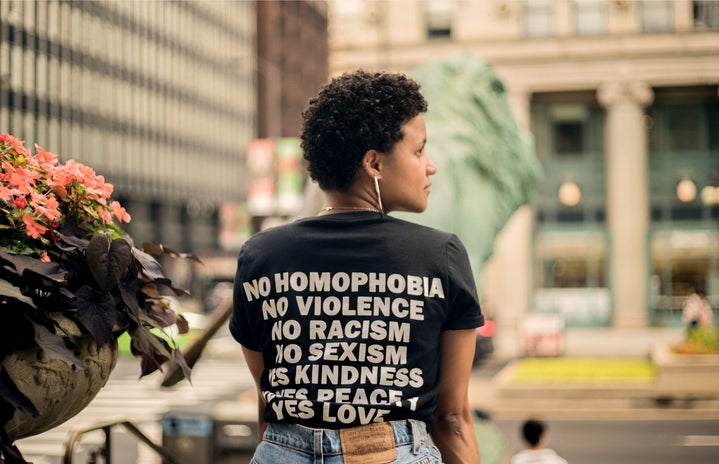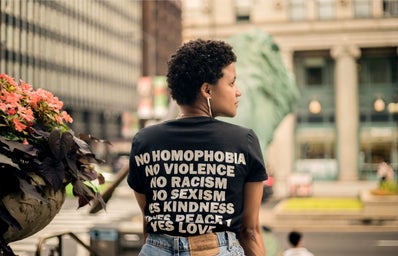Trigger Warning: Mention of sexual assault, violence and homophobia
JK Rowling being branded a ‘Trans-exclusionary Radical Feminist’ (or ‘TERF’) isn’t exactly breaking news. The best-selling author of the Harry Potter franchise seems to be constantly called out for transphobia, but many people do not know the specifics of what she has said and done. This rundown will cover and discuss Rowling’s initial controversial tweets, subsequent manifesto, and relationships and how this has contributed to her inescapable label of TERF.
The controversy started with a tweet in which Rowling denounced the phrase ‘people who menstruate’, arguing the word ‘woman’ shouldn’t be avoided. “‘People who menstruate.’ I’m sure there used to be a word for those people. Someone help me out. Wumben? Wimpund? Woomud?”
Did Rowling know that the aim of this phrase was to be inclusive to trans men who still experience menstruation? Perhaps her initial fear was that women were being erased from the narrative. Belonging to the ‘Ball Breaker’ generation of second-wave feminism of the 80s, the celebration of womanhood and ownership of periods as a symbol of female strength is perhaps what Rowling was aiming to defend. However, with the modern focus on intersectionality, feminism has broadened its scope to include sexuality, race, gender and more. Periods can still represent female strength, but it is true that not all women have periods and not everyone who has a period is a woman. This fact does not erase anyone’s personal womanhood or identity. It is clear Rowling fears the erasure of the female identity with her following explanations: “If sex isn’t real, there’s no same-sex attraction. If sex isn’t real, the lived reality of women globally is erased. I know and love trans people, but erasing the concept of sex removes the ability of many to meaningfully discuss their lives. It isn’t hate to speak the truth.”
Rowling seems to be confusing ‘sex’ and ‘gender’ here, as no mainstream academic thought in medicine or law is refuting the existence of biological sex. Gender, however, is increasingly being understood as a social construct. Therefore, by referring to people who menstruate as just that we aim to refute gendered language as sex should not limit anyone to any gender identity.
The erasure or depreciation of womanhood and the female experience is an understandable concern. However, if Rowling’s tweets only intended to highlight this concern, then maybe she would have experienced such backlash. However, her twitter tirade continued which resulted in a manifesto posted to her website which clarified some questionable views. Despite the incessant insistence on love and respect for trans women and men, Rowling’s language and declarations surrounding trans issues is problematic. She talks of young girls following a trend of transitioning as a way to escape homophobia, mental health problems and the difficulty of girlhood. ‘Detransitioning’ is a process in which someone reverts back to their born gender, and Rowling argues this is a scary and dangerous issue that young people are becoming increasingly subject to. Trans confusion is a valid issue, as access to a new identity may be attractive to some young people. However, without statistics to back up her claims, Rowling’s concern for detransitioning seems to be routed in transphobia. In the UK, taking multiple studies into account, around 3% of trans people detransition. Also, the NHS only allows over 17-year-olds to begin transitioning, with long waiting periods and multiple psychological assessments. Therefore, Rowling’s implications that young children have access to spontaneously fully transition, threatening suicide to get their needs met is unrealistic and untrue. Detransitioning is a serious issue but to use false claims and fear mongering to create a sense of disbelief and danger surrounding young trans people’s identities is regressive.
Rowling goes on to argue that cis men posing as trans women are a threat to biological women and girls. The classic ‘changing room’ argument comes up here, she says:
“I want trans women to be safe. At the same time, I do not want to make natal girls and women less safe. When you throw open the doors of bathrooms and changing rooms to any man who believes or feels he’s a woman – and, as I’ve said, gender confirmation certificates may now be granted without any need for surgery or hormones – then you open the door to any and all men who wish to come inside. That is the simple truth.”
Trans women assaulting cis women is a crime talked about by many conservatives, with little to no evidence this ever happens (excluding assaults within prisons). Violent men will and do assault women wherever they want to, and they don’t have to pretend to be trans to do so. Rowling’s constant reference to these figures as “men who identify as women” dissolves legitimacy of trans women’s identity, lumping them all under the category of ‘potential assaulter’. Many trans women already tackle the constant stereotype of being perceived as predatory, so these assumptions that they are secretly ‘violent men in dresses’ does not help. Apart from anything else, trans people are twice as likely to be victims of crime and abuse in the UK (according to the Office for National Statistics), so why focus on a fear with no evidence when trans people are in double the amount of danger?
Speaking of the ‘violent men in dresses’ conspiracy theory, Rowling’s recent mystery novels expose her transphobic views. Troubled Blood follows a cis man serial killer posing as a trans woman in order to kill biological women… sound familiar? And her pseudonym, Robert Galbraith, holds a disturbing similarity to Robert Galbraith Heath, an infamous psychologist known for his experiments with conversion therapy.
Most recently, Rowling has publicly aligned herself with blatantly transphobic organisations such as ‘Get The L Out UK’, a ‘Lesbian Not Queer’ group whose beliefs include the proclamation that: “Lesbians are exclusively same-sex attracted. Lesbians do not have penises. Lesbians do not want to have sex with men who identify as trans-women.” Nobody is forcing anyone to go near a penis if they do not want to, but sexuality and gender are fluid and it is wrong to say a trans woman is not a lesbian, never mind outright call her a “man”. The website has even more harmful and false information, and Rowling’s association with the members of this organisation firmly places her in a transphobic position.
Rowling’s ‘feminist’ beliefs do not adhere to modern intersectional standards of inclusion. Trans women are women, and their existence and experiences do not harm or impede on cis women’s freedom and validity. Both cis and trans women must listen to one another about their differing and similar experiences, and casting any doubt on the validity or intentions of trans women hinders the acceptance and rights of anyone experimenting or struggling with gender identity.


